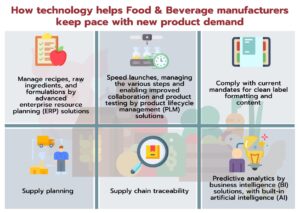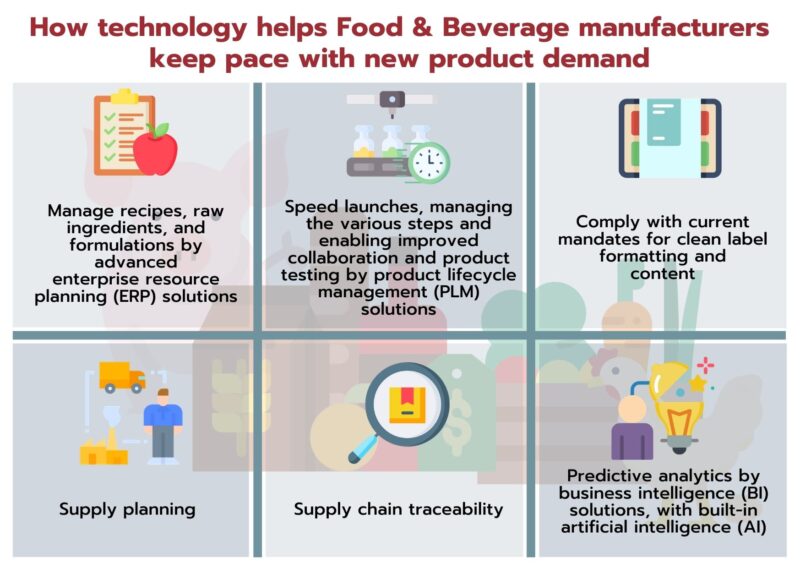
Article by Fabio Tiviti, Vice President ASEAN, Infor
Many consumers are passionate about the quality of their food, the health implications, and the environmental footprint made by food manufacturers. To meet their shifting expectations, food and beverage manufacturers must speed product introductions and develop new offerings that reflect the changing views on what is fresh, healthy, and mindful—and technology can help. It’s not just taste, freshness, and convenience that drive food purchases today. Conscientious consumers also focus on health, wellness, and social issues as they shop for family meals. They take nutrition labels, visibility into suppliers, humane treatment of animals, and environmental sustainability into consideration when shopping for food. While these expectations put added pressure on food and beverage manufacturers, companies that turn to technology to help, should seize the opportunity. Meeting the demands of today’s socially aware consumers can be a valuable differentiator.
The growing demands
It starts with the farm. Consumers today want to learn more about the origins of their food and its journey from farm to fork. The International Food Information Council (IFIC) Foundation states in a recent paper about food trends for 2019, “Americans have a growing appetite for more information about their food, and technology is enabling eaters like never before… it’s also driving transparency across the food supply chain.”
Pharma-nutritional. It is not strictly millennials looking for health-related options. People of all ages are turning to vitamins, minerals, and other ingredients that are potentially beneficial for bone, joint, immune system, digestive, and brain health. Mintel’s research shows 20% of US consumers aged 65-plus currently use a supplement for joint health. As consumers seek food and drink products that reduce
inflammation, more products will feature ginger, turmeric, green tea extract, and medicinal mushrooms.
Crossover health and beauty. Food and beverage manufacturers can benefit from research done by the beauty industry, which once revealed certain berries and spices that have been found to have anti-aging benefits. Also gaining attention are omega-3 fatty acids, biotin, aloe vera, and coenzyme Q10, an antioxidant that benefits heart health. In the past, companies were reluctant to make these investments as they were limited on what health benefit claims they could make. Today’s well-informed consumer requires less background education and explanation of claims on a package. The challenge is more in determining what ingredients are appropriate in what product.
Sustainability. The International Food Information Council (IFIC) Foundation says, “There is a movement towards circularity as new approaches to sustainability span the entire life of a product, from ingredient sourcing to package design, disposal, or reuse. The 360-degree approach reflects the principles of a circular economy, where resources are kept in use for as long as possible, extracting the maximum value while in use and then recovering materials at the end of use.”
Rethinking plastic. Plastics have come under fire globally, pushing demand for new packaging innovations. Bio-based packaging materials will likely be key components to the next generation of responsible packaging. Additionally, initiatives such as “Loop” are attempting to bring back the idea of returnable and re-usable packaging.
Less waste. In 2018, awareness around “ugly produce” grew. Fruit and vegetables, that fall outside of the specifications retailers typically insist upon, got a second chance. Tesco became the exclusive retailer for a range of fruit juices, Waste NOT, which are made from produce designated as “ugly”.
Soil conservation. Healthy, nutrient-rich soil provides the foundation for healthy food. Companies should play a role in helping to replenish the soil. For example, US baby food brand, Gerber’s is hoping that its holistic approach and organic agriculture, featured in its “Clean Field Farming” line, will pay-off and increase biodiversity as well as enhance ecosystems. Additionally, Annie’s Homegrown is another brand helping to raise awareness in this area.
Reducing sugar. Many people are responding to dietary guidance that recommends eating less added sugar, with 77% saying they are taking steps to limit or avoid sugars in their diet, and 59% viewing sugars as negative, according to the 2015–2020 Dietary Guidelines for Americans report. New plant-based and dairy sweeteners are gaining attention and providing new opportunities for updating classic product offerings.
Vegetarians. Plant-based eating continues to gain adoption, with sales of “vegetarian alternatives” growing by 20% since 2017. Only 5% of Americans identify as vegetarians and 3% as vegans, according to a Gallup poll, but others are adding vegetables and reducing protein consumption for general health benefits.
How technology helps manufacturers keep pace with new product demand
In order to remain relevant, food and beverage manufacturers must continually stay tuned into trends and update product offerings. Fortunately, technology can help in several ways:
Product innovation. Introducing new products quickly is a necessity. New product lines can represent healthier choices and include minerals and nutrients associated with wellness. Reducing sugars, artificial colors, and preservatives will also appeal to many modern consumers. Advanced enterprise resource planning (ERP) solutions, purpose-built for the food and beverage industry, will help manage recipes, raw ingredients, and formulations—ensuring the quality is maintained. Product lifecycle management solutions (PLM) also help speed launches, managing the various steps and enabling improved project management, collaboration and product testing.
Clean labels. Transparency and visibility into how food is produced is increasingly important. Labels are the key tactic for conveying messages. “With today’s instant access to information, if a consumer can’t understand or find out where and how a product is made and what’s in it, they’ll be more inclined to leave it behind,” says RSM, which serves as a consultant to the industry. Food and beverage manufacturers can turn to technology to help comply with current mandates for clean label formatting and content. PLM solutions help streamline the process, making it easier to stay within compliance.
Supply planning. As new ingredients come to market and the demand for them starts to expand, the challenge may quickly become a supply shortage. Companies must work closely with their suppliers and leverage supply chain planning tools so retailers can meet the demand.
Supply chain traceability. This is one of the top five food trends in 2019, according to the International Food Information Council (IFIC) Foundation, and it is expected to continue and will cause demand for technology solutions which provide clear product information. They note that as technologies become cheaper and therefore more accessible, more food manufacturers will be able to utilize them to manage supply chain activities. Modern supply chain management solutions are essential for full visibility and tracking suppliers.
Predictive analytics. Modern business intelligence (BI) solutions, with built-in artificial intelligence (AI), will help companies project trends and anticipate market demands. This insight into the future helps procure raw ingredients and plan use of resources, like machinery, packaging, and personnel.
Final takeaway
The world of food and beverage manufacturing is ever-changing—with taste becoming just one of many factors influencing a consumer’s decisions. Today, health, wellness, and social issues like environmental sustainability are just as important. Manufacturers can see this as a challenge or as an opportunity to align with customers. With modern technology in place, companies can seize the chance to speed introductions and offer new product lineups which will appeal to consumers. This can be the ticket to future growth.




